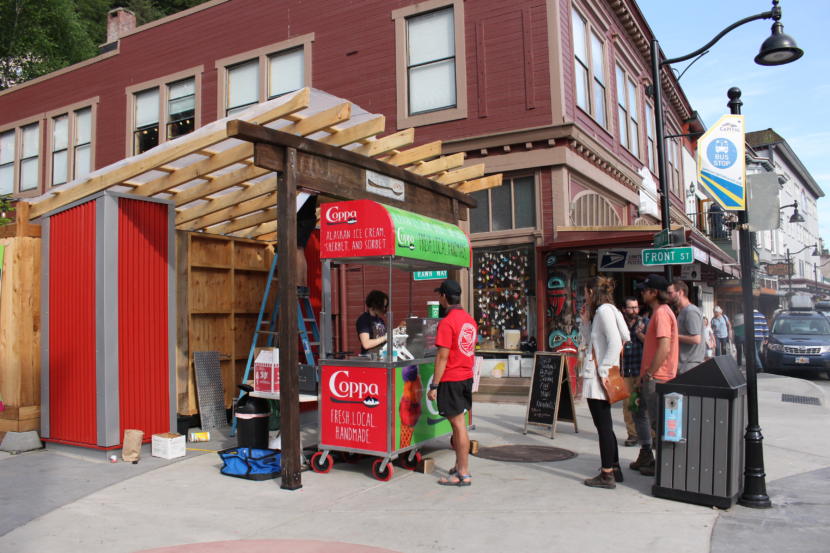
Some big decisions are being made right now that could affect how the Tongass National Forest is managed. The conversation has largely centered on old growth logging.
Should the U.S. Forest Service move away from selling its oldest trees? Originally, the plan was to transition to a different type of timber economy altogether: young growth.
But there are still questions about how to make that industry viable.
One business owner wants to have that talk over ice cream.
Lately, there’s been a bit of a building frenzy at a new Juneau food cart alley. It’s tucked away from the typical bustle of cruise ship passengers.
But you can still spot them with cameras wrapped around their neck.
One of the flagship carts wants those visitors sample a taste of Alaska. It’s an unusual way to eat a salmon.
“You know, it’s kinda fun to think of, ‘Oh, when you’re in Juneau, you have to have the salmon ice cream,’ right?”
Marc Wheeler is the co-owner of Coppa. Other selections from his cart include spruce tip and devil’s club ice cream.
He wants his customers to consider where these flavors come from: the Tongass National Forest. And today, Wheeler is taking another step to reinforce that message.
A flatbed truck arrives carrying a large wooden arch. It’ll be the focal point for Wheeler’s operation. A kind of mini-carport for the ice cream stand, where customers can lick their spoons without getting caught in the rain.
What sets this structure apart is the material it’s being built from: locally milled spruce trees that are only about 50-years old. On an ecological scale, that’s a young tree.
For Wheeler, it was about more than creating something from a niche product. It’s a statement.
He doesn’t think there should be large scale old growth logging in the Tongass.
“Being a business owner, you have all these ways to have a positive impact,” Wheeler said. “These choices of how you buy things can make a big difference.”
Wheeler intentionally sought this wood out and found one family sawmill near Tenakee Springs producing the material.
To be clear, you can run down to any hardware store and buy two-by-fours made out of young growth trees. The lumber just won’t be from Alaska.
That’s something Conor Reynolds from The Nature Conservancy would like to see changed.
“Maybe it’s idealistic or optimistic. But it’s a nut that needs to be cracked,” Reynolds said.
Right now, the nation’s largest national forest is at a crossroads. Federal old growth timber sales were supposed to be phased out over the span of 16 years.
But recent efforts by the State of Alaska and Sen. Lisa Murkowski could undo that. A top federal official is making a decision this summer that could impact transitioning the region’s economy to young growth.
Still, Reynolds thinks the already struggling timber industry can’t sustain itself on a supply of old growth trees forever.
“The death knell is kind of sounding on it,” he said.
He says much of the old growth in the Tongass has already been logged. And the Forest Service has had trouble making the timber sales it does offer pencil out. There’s also ongoing litigation from environmental groups.
So, if there’s going to be a timber industry in Southeast Alaska at all, Reynolds believes cutting young growth trees is the future.
But he acknowledges there are challenges, like convincing investors to take the leap in an already crowded market.
“Some entrepreneur up here would have to find a product that they can make from it that isn’t in direct competition with a place, you know, in Shelton, Washington that’s going through half a billion board feet a year.”
Some small sawmills are creating products in limited runs — making items like shingles and lumber to be sold in state. But, Reynolds says creating more jobs from this is still in its early days.
Back at the food cart alley, builder Steve Klinger is drilling red corrugated metal on top of the young growth wood.
The showpiece — an arch which will be the gateway to Coppa’s ice ice cream stand — has been charred with fire.
Klinger explains it’s a Japanese technique called shou sugi ban that prevents the wood from molding. But another one of the design elements isn’t intentional.
One of the pieces of lumber warped in the sun. There’s a reason young growth typically fetches a cheaper price than old growth. Younger trees have fewer rings in them, which means the wood isn’t always as strong as its counterpart.
Klinger says that might faze some builders.
“An older guy that’s cut wood his whole life would look at it and sort of probably kind of spurn it a little bit,” Klinger said.
But Klinger just saw it as a happy accident. It’s now the curved top of the arch, where customers can nibble bites of spruce tip ice ice cream under what was once a young spruce tree.
A note of disclosure: Marc Wheeler serves on the Alaska Public Broadcasting Commission.